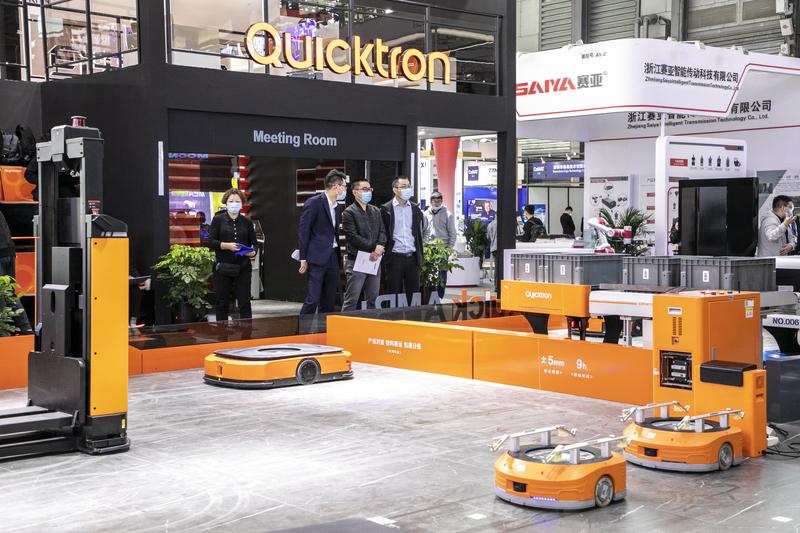 Visitors look at the product display of Quicktron, a Chinese intelligent warehouse robotics firm, during an exhibition in Shanghai in November 2020. (PHOTO PROVIDED TO CHINA DAILY)
Visitors look at the product display of Quicktron, a Chinese intelligent warehouse robotics firm, during an exhibition in Shanghai in November 2020. (PHOTO PROVIDED TO CHINA DAILY)
Quicktron, a Chinese intelligent warehouse robotics firm, is looking to leverage its artificial intelligence-enabled robots to empower the manufacturing sector as the country bets on smart manufacturing to drive the next generation of industrial growth.
"The country's manufacturing sector is transforming to become unmanned but the core demand for unmanned services is not merely based on reduced costs, but also on solving the problems of flexibility, production tempo and safety," said Yang Zhuo, vice-president of Quicktron.
"Logistics robots should not be limited to e-commerce warehouses. They have been increasingly applied in scenarios in manufacturing workshops, online warehouses and raw material warehouses," Yang said.
In the future, robots will no longer just be tools to boost productivity but advanced, smart assistants to humans — driving a new era of intelligent transformatio
Xin Guobin, vice-minister of industry and information technology
He added that the entire manufacturing industry has also undergone tremendous change, where traditional production lines that used to be large-scale are transforming to become multi-variety and small-scale.
"This raises requirements for flexible logistics. For example, many smart factories need to customize products according to customer needs but it is inevitable that orders will fluctuate," Yang said.
"Under such circumstances, when there are few orders, workers will become idle and maybe inefficiently utilized. However, if orders suddenly increase, it is often too late to fill up labor needs. Such flexibility can be easily done by logistics robots as they are able to increase or decrease orders according to needs," he added.
In recent years, the government has been ramping up efforts to develop smart manufacturing, which aims to leverage information technology to drive manufacturing to be more digitalized and intelligent.
Xin Guobin, vice-minister of industry and information technology, said that a wide range of new robotic forms have emerged in the country, thanks to breakthroughs in crucial technologies and declining production costs.
"In the future, robots will no longer just be tools to boost productivity but advanced, smart assistants to humans-driving a new era of intelligent transformation," Xin said.
Quicktron, founded in 2014, mainly leverages its advanced logistics robots to choose and deliver goods in warehouses. Sinopharm, Zoomlion and DHL are among its partners. It has helped Japanese multinational company Mitsubishi build an intelligent robot automatic warehouse, where smart robots help with tasks such as goods replenishment, racking, storage and inventory among others.
Another major partner, Cainiao-Alibaba Group's logistics offshoot-has cooperated with the company to build an intelligent factory of over 35,000 square meters with nearly 1,000 intelligent robots in Wuxi, Jiangsu province.
In December, German warehouse equipment provider Kion Group and Saudi Arabia's Prosperity7 Ventures have jointly led a series C round of fundraising of US$100 million for Quicktron.
With the new fund, Quicktron will beef up its presence by going global. Quicktron founder and CEO Yang Wei said earlier that it aims to expand to over 100 countries and regions and generate 10 billion yuan (US$1.5 billion) in revenue in the coming years.
Quicktron Vice-President Yang Zhuo said, "With the increase in labor costs and the disappearance of demographic dividends, more manufacturing companies have begun to try to reduce costs and increase efficiency through robots."
According to a report by the Ministry of Human Resources and Social Security, more than 9 million college students will graduate this year. Among the top 100 most-needed occupations, more than one-third involve occupations related to manufacturing. Among the 34 occupations with increasing shortages, nearly half are directly related to manufacturing.


